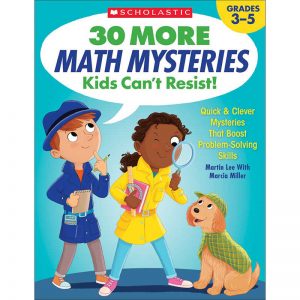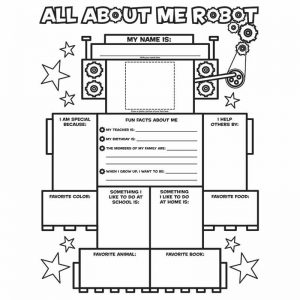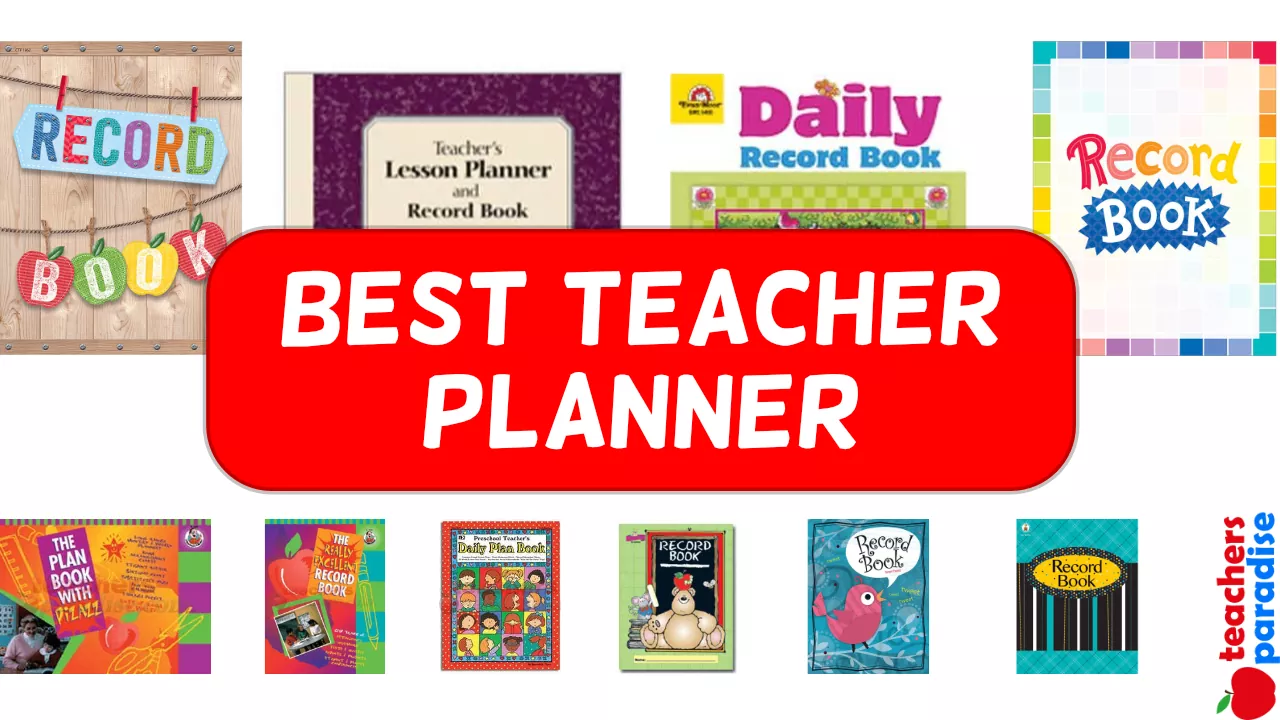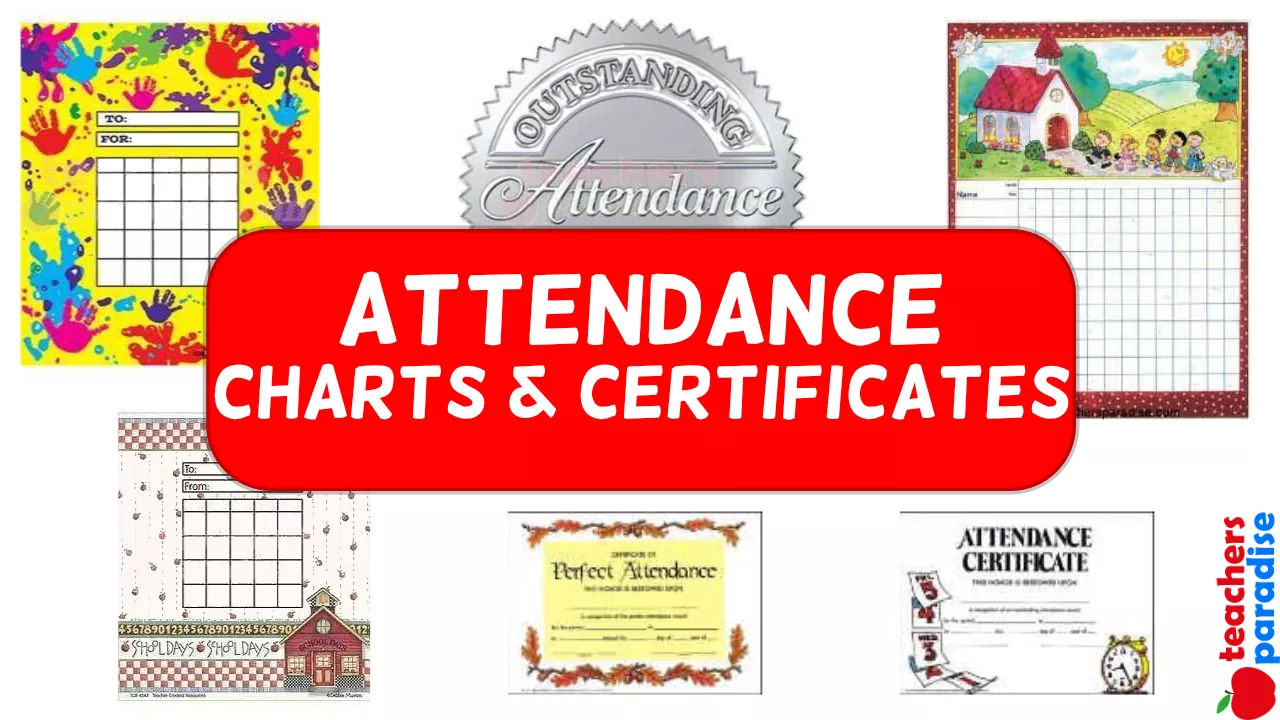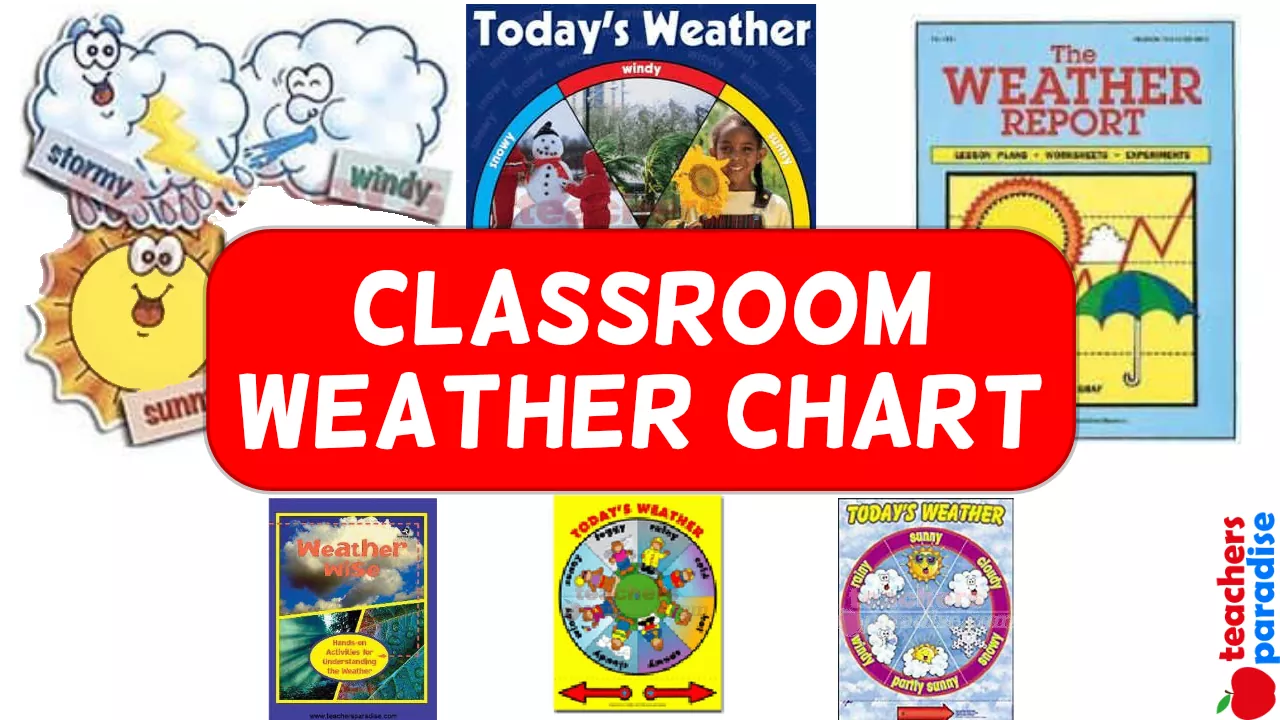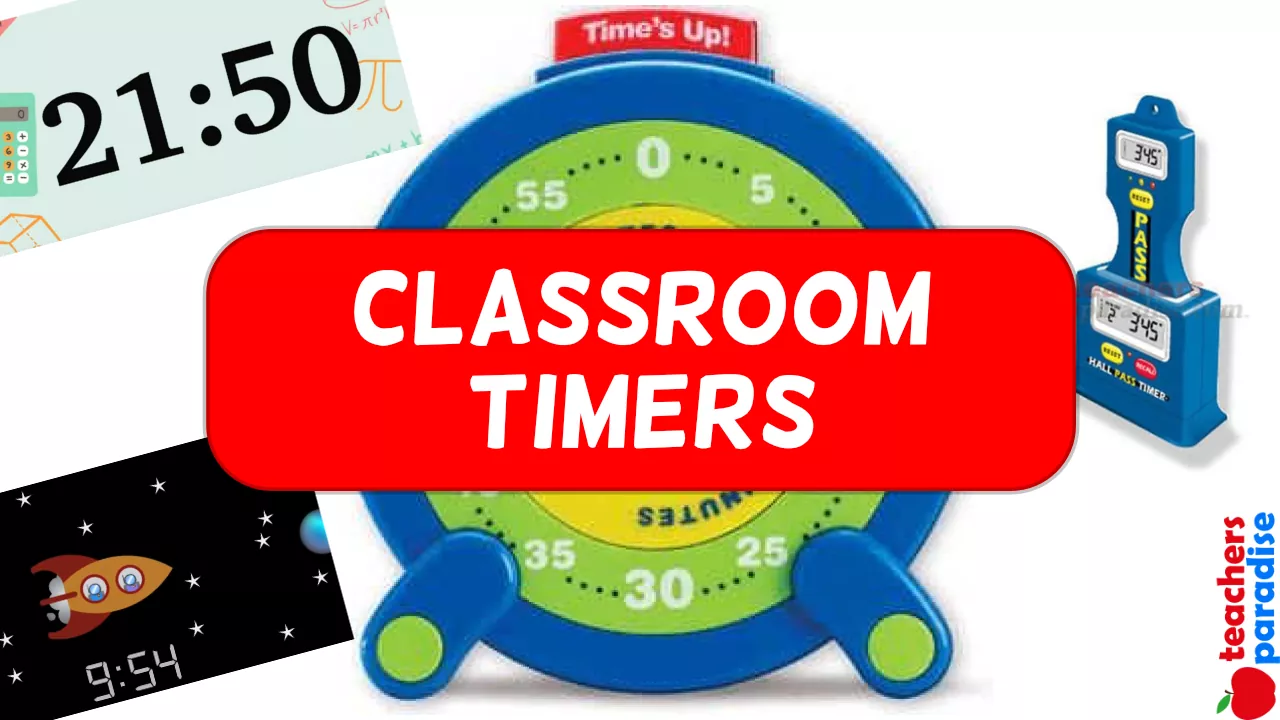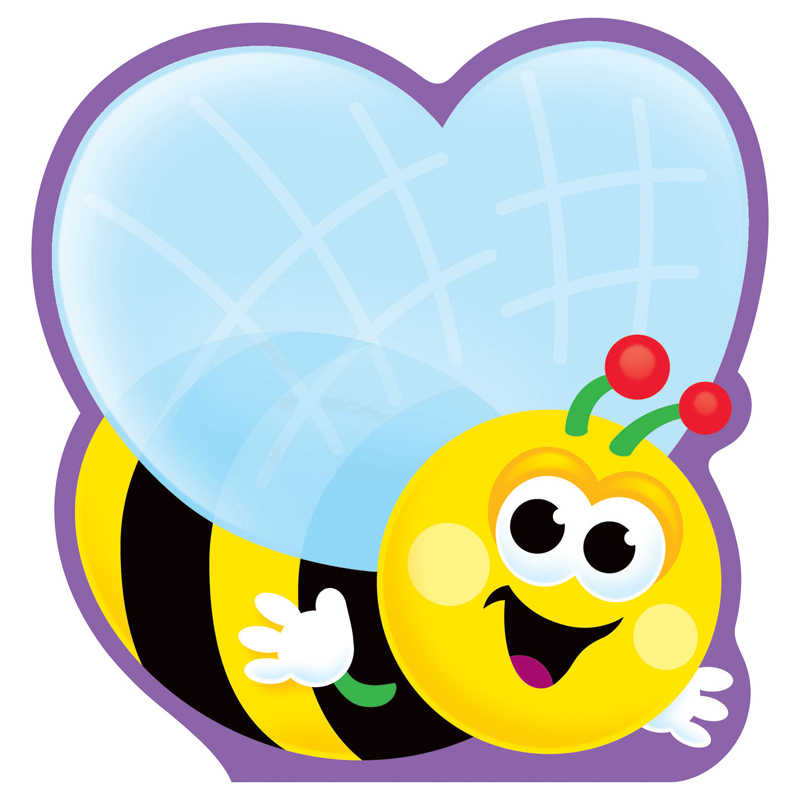Differentiating Instruction in Kindergarten
Attempting to differentiate instruction for a classroom full of energetic, enthusiastic, developmentally different kindergartners can seem like attempting to climb Mt. Everest. Not to worry. With this book, Cindy Middendorf serves as your Sherpa, your guide, and your Sir Edmund Hillary. She has provided a map, a path, and even manageable steps for understanding differentiated instruction in kindergarten, while also holding your hand, cheering you on, and validating what you are already doing in your classroom. Indeed, Cindy acknowledges that most of what you need in order to complete the daunting task of differentiating instruction is already inside you: a caring heart and a willingness to see every child for who he or she really is.
To read Differentiating Instruction in Kindergarten is to spend a day in the classroom of a master teacher—Cindy welcomes readers into the world of teaching kindergarten as she would treasured friends. Her years in the classroom combined with her exceptional writing skills ensure that this is a book that will have a permanent place on your professional bookshelf. You will dog-ear pages, share this book with a friend, and buy one for a colleague, but you will never give your copy away.
WORKSHEET & Sample PDF Activity
Sample PDF Activity
Why do kindergarten teachers need this book? New and experienced teachers alike face the same dilemma as they plan meaningful instruction for our youngest primary learners: so often administrators and curriculum guides tell teachers what to do but not how to do it, and teaching with a differentiated approach is at the top of the list. Cindy helps you navigate through the terms, classifications, assessment tools, and parent communication vehicles you are expected to use—always describing how to use them in a developmentally appropriate way. You’ll find many concrete, relevant techniques and examples, such as parent letters explaining the concept of differentiation, a kindergarten questionnaire that helps link children’s experiences with visual representations of learning differences, and assessment tools such as the I-FAN (informal assessment notepad). These techniques not only help organize instruction effectively and respect learning differences among children; they also represent what I call the “triangle of success,” the parent, teacher, and student working together for success.
After 28 years of teaching, I am rethinking and reenergizing my own instruction. I am excited to bring new ideas from this book into my own classroom to more fully educate each child to his or her full potential. I’ll draw on Cindy’s simple but powerful ideas-turning the occasional worksheet into a WOW sheet, using raps and rhymes for writing numbers, and learning-packed ideas for “sponge activities” that can be used throughout the school year. I love that I can refer back to Cindy’s notes on her lessons and activity ideas and follow her tips to ensure that I implement them successfully and avoid possible pitfalls. I know I’ll come out on the other side with each child being validated, valued, and eager to move to a new level of learning.
Climbing the Mount Everest of differentiating instruction in kindergarten? Take the first step by reading this book. Soon you will be bounding up the mountain, taking in the breathtaking views, and placing your victorious flag at the top. Thank you, Cindy, for showing us the way. —PEGGY CAMPBELL-RUSH, M.ED.
Author of I Teach Kindergarten, Success for Struggling Learners, Tricks of the Trade for Classroom Management, Hip-Hop Alphabop, Group Writing: How Writing Teaches Reading, and Reading, Writing and Word Walls
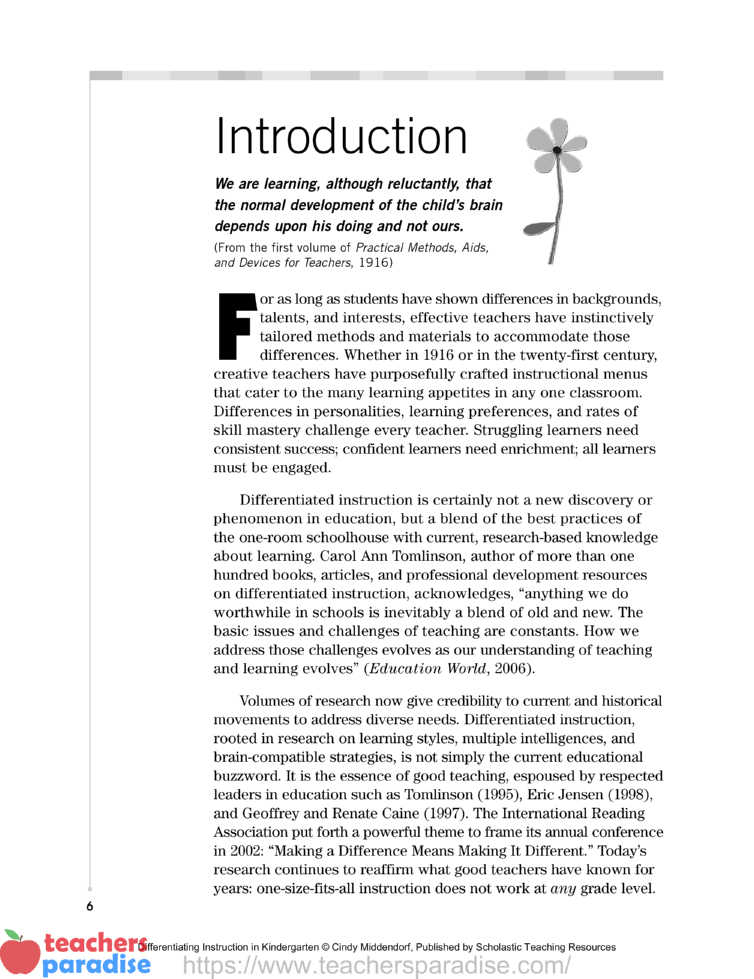
Introduction
We are learning, although reluctantly, that the normal development of the child’s brain depends upon his doing and not ours.
(From the first volume of Practical Methods, Aids, and Devices for Teachers, 1916)
For as long as students have shown differences in backgrounds, talents, and interests, effective teachers have instinctively tailored methods and materials to accommodate those differences. Whether in 1916 or in the twenty-first century, creative teachers have purposefully crafted instructional menus that cater to the many learning appetites in any one classroom. Differences in personalities, learning preferences, and rates of skill mastery challenge every teacher. Struggling learners need consistent success; confident learners need enrichment; all learners must be engaged.
Differentiated instruction is certainly not a new discovery or phenomenon in education, but a blend of the best practices of the one-room schoolhouse with current, research-based knowledge about learning. Carol Ann Tomlinson, author of more than one hundred books, articles, and professional development resources on differentiated instruction, acknowledges, “anything we do worthwhile in schools is inevitably a blend of old and new. The basic issues and challenges of teaching are constants. How we address those challenges evolves as our understanding of teaching and learning evolves” (Education World, 2006).
Volumes of research now give credibility to current and historical movements to address diverse needs. Differentiated instruction, rooted in research on learning styles, multiple intelligences, and brain-compatible strategies, is not simply the current educational buzzword. It is the essence of good teaching, espoused by respected leaders in education such as Tomlinson (1995), Eric Jensen (1998), and Geoffrey and Renate Caine (1997). The International Reading Association put forth a powerful theme to frame its annual conference in 2002: “Making a Difference Means Making It Different.” Today’s research continues to reaffirm what good teachers have known for years: one-size-fits-all instruction does not work at any grade level.
Why This Book?
In three decades of classroom teaching, twenty-two of those years in kindergarten, I lived the frustration of being given curriculum “to cover.” Like experienced colleagues and novice student teachers alike, I often felt torn between “developmentally appropriate instruction” and increasingly higher academic expectations, especially in kindergarten. I quickly learned that no one recipe for instruction yields success for all, yet I was overwhelmed trying to generate all the materials and lesson plans necessary to meet all the needs of all the children.
Like many early childhood teachers, common sense and instinct guided my day-to-day teaching, and I was differentiating long before the term became synonymous with good teaching. My experience, my observations of children in my family and in my classroom, and my interest in brain-based instruction gave me the confidence to acknowledge there was no one way to teach curriculum. My class and I began to learn letters and sounds through music, art, shared reading, sign language, body formations of letters, chants, and connections to words that were important to us. Our math lessons involved building, singing, using people for manipulatives, echoing patterns, drawing, and making everyday calculations of lunch count, snacks needed, and weather graphs.
My initial readings on differentiating for process, product, and content validated my instincts. But kindergarten is a world unto itself, where the learning is in the process. More than any other primary grade, kindergarten teachers must instill a love of learning, a can-do attitude in each child, and a willingness to take a risk. As if that isn’t enough of a challenge, we must also teach all the concepts of literacy and math that will be the solid foundation for future success. And of course, we must do it all while respecting individual differences among all the children in our classroom.
The goal of this book is to offer kindergarten teachers an understanding of differentiated instruction from the early childhood perspective and to provide a variety of strategies, activities, and management tips that will help you in differentiating your kindergarten. The book takes a seemingly overwhelming task and “chunks it down” into doable pieces for teachers in a way that demystifies differentiation for kindergarten teachers.
Teachers new to kindergarten will see the big picture and begin with a mind-set that makes differentiation a natural instructional model. Veteran teachers may recognize (and find validation in) ways in which they are already differentiating, evolve their good teaching strategies into great ones, and recharge their teaching batteries. A differentiated kindergarten is an energizing place for children and for teachers!
What This Book Offers Kindergarten Educators
Chapter 1 outlines differentiated instruction from a kindergarten perspective. You will learn the guiding principles of differentiated instruction as it applies to kindergarten and “sneak a peek” into a typical busy, buzzing kindergarten room where differences in learning styles are honored. This chapter will help you recognize that much of what you already do as a caring, insightful teacher is indeed differentiated.
Chapter 2 will refresh and refine what you learned in education classes about the many ways in which children learn. You will see examples of kindergarten children exhibiting distinct and varying modalities of learning, as well as children demonstrating each of the multiple intelligences. You will even be asked to take a look at your own modalities of learning. This chapter will also help you understand why it is difficult to pinpoint modalities and intelligences at the kindergarten level, and will ease fears about the need to do so.
In Chapter 3, you’ll discover ways to build a profile for each child without “pigeonholing” each. You’ll find tips for using parent input to better know each child and checklists to help you understand the unique and emerging learning style of each child. Also in Chapter 3, you’ll find strategies for using formal and informal assessment tools, along with literacy and math checklists for kindergarten.
Chapter 4 describes simple, step-by-step ways to begin differentiating in your kindergarten classroom. You’ll learn how to get parents and children on board with the idea that not all children will be doing the same thing at the same time. You’ll explore ways to manage your classroom that will allow you to concentrate on teaching so that all may learn. This chapter also includes specific differentiated activities that will keep children engaged and learning while you are working one-on-one or in small groups.
Chapter 5 is packed with ideas to motivate children, teach key skills, and meet diverse needs. The chapter offers suggestions for addressing and accommodating the wide range of skills and maturities in your classroom, including fine-motor, vision, early literacy, and math readiness. You’ll find innovative and inexpensive ways to design and differentiate centers as well as whole-group instruction.
Throughout the book, real samples of real kindergartners at work illustrate differentiation in action: in classroom scenarios, in photographs, and in student work. Also sprinkled throughout the book are references and resources that provide a research-based rationale for differentiated instruction and give you options for further learning. Teachers, like children, approach learning in diverse ways. Whether you have taught for decades or for days, or are anticipating your first teaching assignment, I hope this book gives you the confidence to always put the children, one by one, ahead of the curriculum.

Chapter 1
What Does Differentiated Instruction Mean in Kindergarten?
You teach kindergarten. Lucky you! There are few other places in the universe where there is such honesty, love of learning, self-acceptance, intrinsic motivation, and sheer joy in living. As a caring kindergarten teacher, you receive a healthy daily dose of ego building from children who adore you. If only they knew how you agonize over creating a nurturing world where each of them can learn, blossom, and flourish at their own rate.
Kindergarten teachers have always wanted each child to feel valued, confident, and successful. When we let our common sense direct our teaching, children bloom. Yet in today’s standards-driven, assessment-dependent, “push-down” curriculum world, conscientious teachers often feel like jugglers keeping too many balls in the air: addressing standards, accommodating IEP’s, balancing parent expectations, keeping abreast of new research, and managing a classroom of unpredictable live wires. Common sense tells us that the most important ball to hold in the air is the child. We frequently become frustrated when the other demands on our time and energy keep us from doing what we do best: nurture the love of learning in children.
Differentiated instruction is a philosophy, a way of thinking and structuring our classrooms that puts children first. It lets a child’s success be measured by his or her own individual growth. It allows a teacher to step back, survey an active, buzzing classroom and say, “Yes!” Because early childhood teachers are so in tune with children’s developmental stages, chances are that you already employ a lot of the rock-solid principles of differentiated instruction:
- Do you have high expectations for all children?
- Do you model respect for all children’s work?
- Do you consciously integrate physical movement, music, and art into lessons?
- Do you have free-play centers for building, drawing, reading, imagining, and exploring?
- Do your children have choices in materials, centers, and assignments?
- Do you use time flexibly?
- Do you incorporate whole-group instruction, small-group instruction, and one-on-one instruction?
- Is the composition of your small groups flexible and ever changing?
- Do you use ongoing, authentic assessment and “kid-watching” to adjust and evaluate teaching as well as learning?
- Do you assess children according to their individual growth?
- Are your children relaxed, eager, and actively engaged?
- Are there times in your room when children are working on several different activities?
- Do you vary your teaching style, ask open-ended questions, and initiate discussions?
- Are children involved in classroom problem solving?
Chances are that you answered yes to most of these. Kindergarten teachers instinctively know that each child is unique. Congratulations! You will not need to reinvent the wheel to differentiate your classroom. You will validate the effective teaching strategies you already employ, focus on making your good teaching better, and celebrate the strengths and successes of all your students.
The Instructional Menu: Serving All Appetites
Current research is making us increasingly aware of the importance of recognizing and honoring the uniqueness of each learner. Every kindergarten teacher acknowledges, struggles with, and works endlessly to accommodate widely differing strengths, needs, personalities, and developmental levels in one classroom. Most teachers of young children can competently discuss auditory, visual, and kinesthetic modalities of learning. Likewise, we all have been schooled in Gardner’s theory of multiple intelligences (1993 and 2000). Yet understanding these differences in our children is easier than supporting these differences. Differentiated instruction reinforces children’s strengths, allows different children to be mastering skills in different ways, and encourages children to explore and process information through varying learning preferences (modalities). Chapter 2 will help you to recognize the preferred modalities of learning among your students and to identify the intelligences within your classroom. The caveat is acknowledging that the younger the children, the less defined those modalities and intelligences are.
Differentiated instruction is more than just having different students involved in different activities. Differentiated instruction means that the teacher has consciously tried to engage children in learning and reinforcing skills through an array of methods while addressing curriculum standards. Differentiated instruction means that one instructional goal or objective can be attained using different strategies, different contents, and/or different finished products for different children. Eric Jensen, an expert in the exploding field of brain research, notes that “the more ways we learn something, in more situations, with more intelligences, more emotions, more forms of media,” the more likely we will embed that learning (1997).
Sound overwhelming?
With so many children processing information in so many different ways (modalities), with so many different strengths (intelligences), at so many different rates (skill levels), and at so many different levels of maturity (developmental ages), what’s a teacher to do? In addition to the normal range of learning preferences, and the normal bell curve of abilities, an increasing number of special needs students are being integrated into traditional classrooms.
Most teachers have little background for dealing with special needs, few on-site resources for support, and too little time in the school day to meet the demands. Sadly, the task overwhelms many teachers who then fall back to the traditional comfort zone: one-size-fits-all teacher-designed activities that all children must complete.
Totally differentiating every lesson every day for every student is unrealistic. Yet as we learn more and more about the brain development of youngsters and understand how neural pathways are constructed, we cannot ignore the unique strengths and needs of each child.
A child-friendly approach to handwriting practice: As a class, the children repeatedly trace the prewritten k, first with a finger and then with crayons as they repeat the letter name and sound., “This is /k/-/k/- /k/, k.” They trace around the k and practice making the k without tracing. Finally, in the Letter Center, they trace with glue, and affix kidney beans to reinforce the letter sound.
Validate Yourself: You’re Already Differentiating!
Now for the good news: once familiar with differentiated instruction, most kindergarten teachers will realize they are already instinctively differentiating in small ways. Early childhood educators are masters at intuitively sensing children’s unique strengths and needs. Teachers who use a variety of instructional methods (whole group, small group, one-on-one, and independent learning centers) already know that some children learn best in one arena and others in another. Learning centers, long an integral piece of most kindergarten classrooms, provided differentiated instruction long before differentiated instruction was a research-based best practice.
More good news: once a teacher begins to use some basic strategies for differentiation, the enthusiasm and success of the students bring the joy back to teaching. And differentiating your kindergarten instruction is not difficult! The more ways a kindergartner is exposed to a skill, concept, or idea, using different intelligences, in different situations, with different materials, the more the learning is internalized. When Anna paints a sunflower, hears a story about a sunflower, sequences the growth of a sunflower, writes a sentence about a sunflower, sings and uses her body to show sunflower growth, picks the seeds from a sunflower head and uses them in an art project, Anna knows sunflowers! When Kenny practices sight words by playing bingo with sight words, writing sight words with magnetic letters, using chants and cheers to spell sight words, and highlighting sight words in print, Kenny learns sight words. Children of all learning strengths and skill levels find success when a caring teacher designs a learning smorgasbord.
A Look Inside a Differentiated Kindergarten
It is 10:20 A.M. A busy hum is heard as children move about and interact with materials, other children, and their teacher, Ms. K. The lesson begins on the story rug as Ms. K reads aloud from the nonfiction big book, A Butterfly Is Born by Melvin Berger. After the reading, the children curl up on the rug like tiny caterpillar eggs. At Ms. K’s direction, they “hatch” and immediately “eat” their tiny eggshells. They continue to play-act, munching their way around a leaf and spinning themselves into chrysalises. Once they emerge as graceful butterflies, they glide on silent wings around the room and come to light on the rug where they sing the “Butterfly Song.”
Now all are engaged in varying related activities in the room. Some are working with butterfly sequencing puzzles; others are at the easels painting the life stages of the butterfly. A group is in the Book Nook, poring over butterfly, moth, and insect books, and using tracing paper to reproduce pictures. A few are at the clay table designing caterpillars and butterflies. Ms. K is circulating, staying especially close to those who are at the writing center putting finishing touches on their butterfly sentences.
In a few minutes, Ms. K will once again gather the children on the rug where today’s Shared Reading lesson will focus on finding sight words and rhyming words in a poem about butterflies.
At the kindergarten level, children are still exploring and establishing their own preferred modalities and intelligences. Although young children from an early age give unmistakable signs of preferred intelligences and modalities, most eagerly explore all arenas of their world through all their senses. Like sponges, they absorb information easily and are willing to move outside of their own comfort zone (take a risk) to learn. In our kindergarten instruction, we should be presenting the same information in a variety of ways, engaging all the modalities as we present information. For skill practice and reinforcement, we need to offer such a variety that children have opportunities to explore all modalities and to reinforce their strongest modality whenever possible. However, most children will joyfully embrace all activities you present, as long as those activities are developmentally appropriate. Young children will eagerly devour all that is offered on the instructional buffet table, and eventually, most will settle into those types of activities that best satisfy their own appetites.
Whenever you teach a concept in a variety of ways, you greatly increase the chances of reaching each student. You multiply the chances that each student will remember what you have taught, since you have created many neurological pathways to access the same information. Then, when you match the reinforcing and enrichment activities to the child’s learning preferences, learning happens effortlessly.
Differentiated instruction incorporates a smorgasbord of teaching methods, a variety of tools and materials, and a spectrum of curricular themes matched to the needs and levels of the learners. It means finding the switch that “turns on” each student. It means moving away from the traditional one-size-fits-all design and timing of instruction.
Differentiated instruction in kindergarten (or any grade level) is not ability grouping, nor is it a commercially prepared, scripted program. Although a differentiated classroom is actively buzzing, it is not chaotic or unmanaged. Groups are flexible and ever changing, rather than homogeneously rigid. While we effectively offer varying levels of material, differentiation is much more than a diet of enrichment for more-ready learners and constant repetition for learners needing more support.
Brain Fact
When learning occurs, cells are stimulated to grow branch-like extensions called dendrites. Each dendrite provides another pathway with which connections can be made. What we call “greater depth of meaning” simply means cells making more connections and new pathways to other cells. The secret is to provide multiple contexts for learning the same thing. Jensen, Brain Compatible Strategies, 1997
Wise is the teacher who views a classroom through the eyes of a five-year-old, and wise is the teacher who realizes that not all five-year-old eyes view the world in the same way. Lucky are the fiveyear-olds whose teacher sees each one as able!
As we begin to differentiate our classrooms, we give our children and ourselves permission to focus on long-term goals. Instead of “How do I fit it all in today?” we begin to ask, “Where in the curriculum does everyone need to be at the end of this week (month, quarter, semester)?” Then we can plan several routes to reach that goal. Like travelers, some children will arrive at the destination via the scenic route, some by highway, and some by air, train, or bicycle. The journey for each should reinforce the joy of travel, and ultimately, the joy of reaching the destination.
The joy of learning, the growth of self-confidence, and the willingness to take a risk are the ultimate measures of success in kindergarten.
Table of Contents
Foreword – 4
Introduction – 6
Chapter 1
What Does Differentiated Instruction
Mean in Kindergarten? – 10
Chapter 2
Modalities and Intelligences:
The Channels for Learning – 17
Chapter 3
Building a Profile for Your Learners – 27
Chapter 4
Setting the Stage for Differentiating – 55
Chapter 5
A Menu of Skill-Building Activities
to Satisfy Every Learner’s Appetite – 83
Professional References – 125
Children’s Literature Cited – 127
Index – 128

